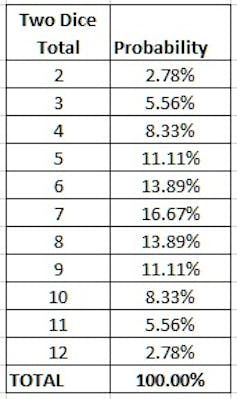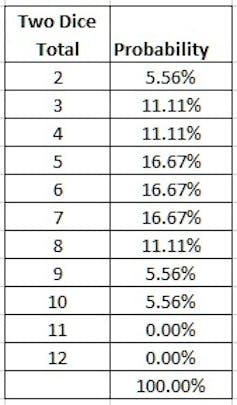How to cheat at dice – from an expert in games

Archaeologists recently uncovered a 600-year-old die that was probably used for cheating. The wooden die from medieval Norway has two fives, two fours, a three and a six, while the numbers one and two are missing. It is believed that the die was used to cheat in games, rather than being for a game that requires that specific configuration of numbers.
Today, dice like this with missing numbers are known as tops and bottoms. They can be a useful way to cheat if you’re that way inclined, although they don’t guarantee a win every time and they don’t stand up to scrutiny from suspicious opponents (they only have to ask to take a look and you’ll be found out). But there are several other options of cheating at dice too, and I’ll talk you through some of them here.
It should be noted that using these methods in a casino are illegal and I’m not suggesting you adopt them in such establishments – but it’s an interesting look at how probabilities work.

For a fair die, each number has an equal one in six, or 16.67%, chance of appearing. In the case of the die found in Norway, the numbers four and five are twice as likely to appear (as there are two of them), so have a one in three, or 33.33%, chance. The table shows these probabilities.

It does not take too much imagination to see how tops and bottoms can be used to your advantage. Let’s assume that we are playing with two normal dice. There are 36 possible outcomes but only 11 possible total values the dice can produce. For example, six-four, four-six and five-five all add up to ten.
If we instead used two top and bottom dice with only the numbers one, four and five on them, we can never roll a total of 11 or 12 as we don’t have a six to make that total. Similarly, we can never get a total of three as we don’t have a two and a one. But we also cannot get any combination that would produce a total of seven, which would otherwise be the most likely total to appear with a probability of 16.67%. In a game of craps there are times when it can be really bad to throw a seven. So if you are playing with dice where a combination of seven is impossible, you have a distinct advantage.

As these kind of tops and bottoms dice will not pass even a cursory, closer inspection, they have to be brought into the game for a short time and then switched out again. This requires the cheat to be an expert at palming, meaning being able to conceal one set of dice in your hand and then bring them into play while simultaneously removing the other dice.

Using two dice, with the same three numbers repeated, might be too risky so a cheat would probably only want to switch in a single die into the game. In our example, this would mean no longer avoiding a total of seven, which would still have a probability of 16.67%. But now the totals of five and six would also have this probability.
In craps the odds are such that when you are required to avoid a seven, it is the number most likely to appear. Switching in a single dice can still reduce the house’s chances of winning, by making other totals equally likely to appear.
Loaded dice
Loaded dice can make cheating harder to spot. These can take a number of different forms. For example, some of the spots on one face could be drilled out and the holes filled with a heavy substance so the die is more likely to land with this face down. If you were to drill out the number one, this means that the number six is more likely to appear, as the six is always on the opposite face to the one. Another way of loading a die would be to slightly change its shape, so that it is more likely to keep rolling. This may only give a small advantage, but it could be enough to tip the game in the cheat’s favour.
With tops and bottoms it is easy to know the probabilities of various totals appearing. This is not the case with loaded dice. One way of gauging the probabilities is to toss the dice a number of times (possibly thousands) and work out what numbers appear and how often. If you know that seven is less likely to appear than it would with fair dice then, over the long run, it would be a cheat’s advantage.
Controlled throws
One other way to cheat doesn’t require an unfair die at all but involves learning how to throw in a very controlled way. This can involve effectively sliding or dropping the die so the desired number appears. If two dice are used, one can be used to trap the other and stop it bouncing. If this is done by a skilled operator, it is very difficult to see.
Dominic LoRiggio, the “Dice Dominator”, was able to throw dice in what appeared a normal way but so that they would land on certain numbers. This was done by understanding how dice travel thorough the air and controlling each part of the throw. It took many (many, many) hours of practice to perfect, but he was able to consistently win at the craps table.
Many would consider what LoRiggio did to be advantage play, meaning using the rules to your advantage. This is similar to card counting in blackjack. The casinos may not like it, but you are technically not cheating – though some casino may try to make you shoot the dice in a different way if they suspect you are doing controlled throws.
Graham Kendall, Professor of Computer Science and Provost/CEO/PVC, University of Nottingham
This article was originally published on The Conversation. Read the original article.




















